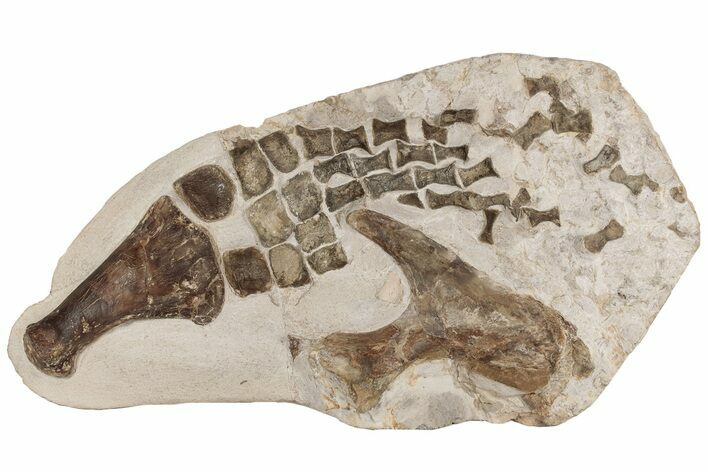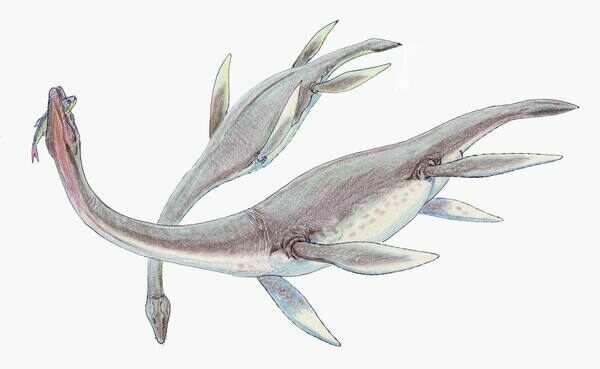This Specimen has been sold.
24" Fossil Plesiosaur Paddle & Pelvic Bone Association - Asfla
This is a well-preserved fossil association of a partial Plesiosaur paddle and pelvic bone that was collected from the Upper Cretaceous (Early Turonian Stage) deposits of Asfla, Morocco, north of Goulmima. There are three primary species of Plesiosaur described from this area; Thililua longicollis, Manemergus anguirostris and Libonectes atlasense. It is rather difficult to place this paddle in any of the three species, so we have decided to leave it unidentified. As the paddle approaches the proximal end, the podials ("finger bones") become increasingly disarticulated. The large flat bone is the ischium, part of the pelvic girdle. Given the thickness of the femur and the presence of a portion of the pelvic girdle, this was most likely a rear paddle.
The humerus and first two digits are composites from another piece but all of the other bones are in their original position in the rock with minimal repair.
The humerus and first two digits are composites from another piece but all of the other bones are in their original position in the rock with minimal repair.
Plesiosaurs were aquatic reptiles. They had small heads, long necks, broad, flattened bodies, short tails and large flippers or paddles. They are one of the best described groups of fossil animals with a total of 110 known species, many from complete or nearly complete fossils. The largest known is Elasmosaurus at 40 feet (12 meters), and the smallest was Thalassiodracon at just under 6 feet (1.5 meters). They first appear in the fossil record near the end of the Triassic Period, starting with Thalassiodracon from about 203 million years ago. They disappear from the fossil record about the time of the Cretaceous-Paleogene Extinction, along with the dinosaurs and most other reptiles.
Plesiosaurs were almost comical in their appearance: small heads full of sharp, cylindrical teeth; wide, comparatively flat bodies; short tails; and four large paddles or flippers. They are so odd-looking that when originally found, the first Plesiosaur fossil was mistaken for a new kid of Pterosaur. Even when the first Plesiosaur went on display, it had its head mounted on the wrong end! Plesiosaur necks could also have large numbers of vertebrae: Albertonectes had 72 in its neck!
Plesiosaurs swam by moving their paddles or flippers in much the same way that modern sea turtles do. This would have made them efficient and maneuverable, but not particularly speedy. Due to their long, thin necks and flippers, it is unlikely that Plesiosaurs left the water. If they did, they would not have been able to travel far. It had long been thought that Plesiosaurs left the water to lay eggs in much the same way as modern sea turtles. Recent evidence seems to prove they bore live young, making theories that they left the water less likely. It is widely held that plesiosaurs were not the fastest swimmers in the sea, cruising to catch their preys of various fish, squid, and other mollusks.
Plesiosaur fossils have been found worldwide. The first described fossil was found in Kansas. Since then, they have been found on every continent. Most commercially available Plesiosaur fossils come from Morocco and Kansas.
Plesiosaurs were almost comical in their appearance: small heads full of sharp, cylindrical teeth; wide, comparatively flat bodies; short tails; and four large paddles or flippers. They are so odd-looking that when originally found, the first Plesiosaur fossil was mistaken for a new kid of Pterosaur. Even when the first Plesiosaur went on display, it had its head mounted on the wrong end! Plesiosaur necks could also have large numbers of vertebrae: Albertonectes had 72 in its neck!
Plesiosaurs swam by moving their paddles or flippers in much the same way that modern sea turtles do. This would have made them efficient and maneuverable, but not particularly speedy. Due to their long, thin necks and flippers, it is unlikely that Plesiosaurs left the water. If they did, they would not have been able to travel far. It had long been thought that Plesiosaurs left the water to lay eggs in much the same way as modern sea turtles. Recent evidence seems to prove they bore live young, making theories that they left the water less likely. It is widely held that plesiosaurs were not the fastest swimmers in the sea, cruising to catch their preys of various fish, squid, and other mollusks.
Plesiosaur fossils have been found worldwide. The first described fossil was found in Kansas. Since then, they have been found on every continent. Most commercially available Plesiosaur fossils come from Morocco and Kansas.
SPECIES
Unidentified Plesiosaur
LOCATION
Asfla, Morocco
SIZE
Paddle: 24" long (disarticulated), Pelvis: 10.7 x 7.2", Rock: 25.15 x 13.25"
CATEGORY
SUB CATEGORY
ITEM
#199981
We guarantee the authenticity of all of our specimens.
 Reviews
Reviews

















